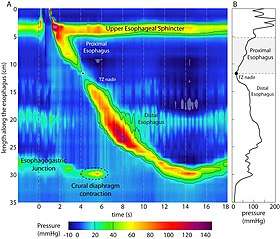High resolution manometry
High-resolution manometry (HRM) is a gastrointestinal motility diagnostic system that measures intraluminal pressure activity in the gastrointestinal tract using a series of closely spaced pressure sensors. For a manometry system to be classified as "high-resolution" as opposed to "conventional", the pressure sensors need to be spaced at most 1 cm apart.[1][2] Two dominant pressure transduction technologies are used: solid state pressure sensors and water perfused pressure sensors.[2][3] Each pressure transduction technology has its own inherent advantages and disadvantages. HRM systems also require advanced computer hardware and software to store and analyze the manometry data.[2]
| High resolution manometry | |
|---|---|
 This figure shows a pressure topography plot during a normal swallow, measured using a 36-channel high-resolution manometry system. Time is on the horizontal axis and length along the esophagus on the vertical axis. Pressure magnitude is encoded in color corresponding to the scale shown at the bottom. High-pressure regions are denoted by the red end of the spectrum while the low pressure regions by the blue end. Data collected at The University Hospital, Cincinnati and plotted using MATLAB (The MathWorks Inc., Natick, MA) by Sudip K. Ghosh, PhD (University of Cincinnati) | |
References
- Brierley, Stuart; Costa, Marcello (2016). The Enteric Nervous System: 30 Years Later. Springer. p. 218. ISBN 9783319275925. Retrieved 18 January 2018.
- Conklin, Jeffrey; Pimentel, Mark; Soffer, Edy (2009). Color Atlas of High Resolution Manometry. Springer Science & Business Media. p. 4. ISBN 9780387882956. Retrieved 18 January 2018.
- Bredenoord, Albert J.; Smout, André; Tack, Jan (2016). A Guide to Gastrointestinal Motility Disorders. Springer. p. 17. ISBN 9783319269382. Retrieved 18 January 2018.
External links
- HRM systems (from EBNeuro S.p.A.)
- HRM systems (from Sierra)
- HRM systems (from Medical Measurement Systems)
This article is issued from
Wikipedia.
The text is licensed under Creative
Commons - Attribution - Sharealike.
Additional terms may apply for the media files.